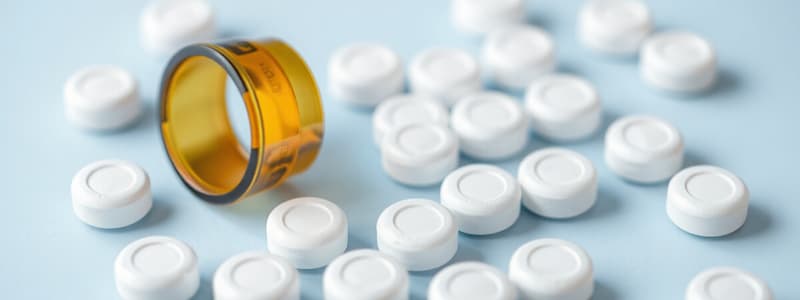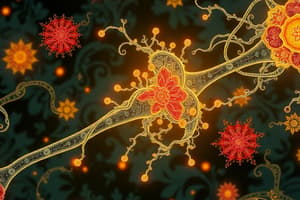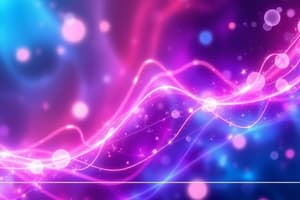Podcast
Questions and Answers
What are the primary actions of drugs as stated in the content?
What are the primary actions of drugs as stated in the content?
- Absorption and Excretion
- Activation and Deactivation
- Stimulation and Suppression
- Excitation and Inhibition (correct)
Which administration route is NOT associated with procaine?
Which administration route is NOT associated with procaine?
- Neuraxial
- Topical administration
- Peripheral nerve blocks
- Intravenous (correct)
Which symptom is associated with CNS toxicity from procaine?
Which symptom is associated with CNS toxicity from procaine?
- Respiratory distress
- Cardiac arrest
- Convulsions (correct)
- Hypertension
What is one of the clinical uses of pentobarbital?
What is one of the clinical uses of pentobarbital?
What is the first step in the preparation of the animal for procedures?
What is the first step in the preparation of the animal for procedures?
Which landmark is used to locate the sciatic nerve?
Which landmark is used to locate the sciatic nerve?
What angle should the needle be inserted to administer procaine?
What angle should the needle be inserted to administer procaine?
During a convulsion, which of these symptoms can occur?
During a convulsion, which of these symptoms can occur?
Flashcards
Animal Preparation
Animal Preparation
A process of preparing an animal for an experiment, ensuring minimal stress and establishing a baseline for observation.
Limb Stiffness in Convulsions
Limb Stiffness in Convulsions
A type of muscle contraction where the muscle remains contracted, leading to stiffness and rigidity.
Opisthotonus
Opisthotonus
A type of posturing where the head and neck are bent backward, arching the back. It's a sign of severe convulsions.
Excitation (in Pharmacology)
Excitation (in Pharmacology)
The ability of a drug or substance to excite or stimulate the body's nervous system.
Signup and view all the flashcards
Inhibition (in Pharmacology)
Inhibition (in Pharmacology)
The ability of a drug or substance to suppress or inhibit the activity of the body's nervous system.
Signup and view all the flashcards
General Effects (of a drug)
General Effects (of a drug)
A type of adverse reaction to a drug or substance that affects the entire body, rather than just a specific area.
Signup and view all the flashcards
Therapeutic Effects
Therapeutic Effects
The desired effect or outcome of a drug or treatment, intended to improve health.
Signup and view all the flashcards
Adverse Reactions
Adverse Reactions
Unfavorable effects of a drug or substance that may occur in addition to the desired effects.
Signup and view all the flashcardsStudy Notes
Experiment 3: Basic Actions or Effects of Drugs
- Drug actions can be categorized as excitation or inhibition.
- Drugs can have local or general effects.
- Drugs have therapeutic effects, or intended benefits.
- Drugs also have adverse, or unwanted reactions.
Procaine (Local Anesthetic)
- Action: Blocks nerve conduction of sensory impulses, inhibiting pain.
- Administration Routes: Topical application, infiltration, peripheral nerve blocks, neuraxial (spinal, epidural, caudal).
Procaine Toxicity
- CNS Symptoms: Excitation (convulsions) or depression.
- Cardiovascular System Effects: Potentially affected.
- Allergic Reactions: Possible.
- Treatment: Airway management, support of breathing and circulation, and convulsion suppression (e.g., intravenous diazepam/pentobarbital).
Pentobarbital (Sedative-Hypnotic)
- Action: Blocks nerve conduction of sensory impulses, inhibiting pain.
- Clinical Uses: Sedative, hypnotic, anticonvulsant, antiepileptic, anesthesia, pre-anesthesia medication.
Procedures: Animal Preparation
- Gently handle the rabbit to minimize stress.
- Place the rabbit in a prone position on a soft, non-slip mat.
- Observe the rabbit's normal behavior and movement (baseline).
Procedures: Locating the Sciatic Nerve
- Identify the ischial tuberosity (bony protrusion at the base of the tail).
- Feel for the greater trochanter (bony landmark on the top of the thigh bone).
- Locate the sciatic nerve in the depression ("notch") between these landmarks.
Procedures: Preparing for Injection
- Clean the injection area with an alcohol wipe and allow it to dry.
- Draw up the correct dose (1 ml/kg of 2% procaine) into a 5 mL syringe.
Procedures: Administering Local Anesthetic
- Hold the rabbit's leg steady.
- Insert the needle at a 30-degree angle into the sciatic nerve's notch, aiming toward the tail.
- Slowly inject the procaine solution over 30 seconds, ensuring the needle does not move.
Procedures: Observing Local Effects
- After injection, monitor the hind limb for muscle relaxation and loss of sensation.
- Use a cotton swab to gently stroke the paw to test for withdrawal reflex.
Procedures: Administering Systemic Anesthetic
- Draw up 4 ml/kg of 2% procaine into a 5 mL syringe.
- Inject the procaine intramuscularly into the thigh muscle on the opposite side of the local injection site.
- Monitor the rabbit for CNS depression or excitation.
Procedures: Managing Intoxication
- In case of convulsions, draw up 0.5 ml/kg of sodium pentobarbital into a syringe.
- Slowly inject the pentobarbital into the marginal ear vein, observing the rabbit's response.
- Monitor drug antagonism, observing the effect during injection.
Procedures: Documentation and Analysis
- Record the onset, duration, and intensity of any observed effects.
- Document any adverse reactions and the rabbit's recovery time.
Convulsion (Signs/Symptoms)
- Limb Stiffness: Muscle rigidity due to sustained muscle fiber contraction.
- Opisthotonus: Specific posture in severe convulsions involving backward arching of the head and neck.
- Dyspnea: Difficulty breathing due to chest restriction caused by muscle contractions.
Studying That Suits You
Use AI to generate personalized quizzes and flashcards to suit your learning preferences.



